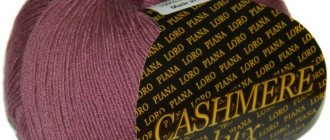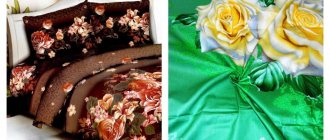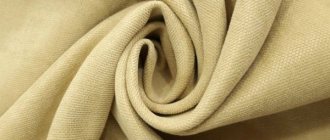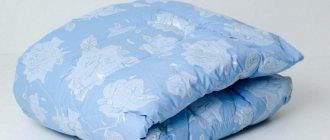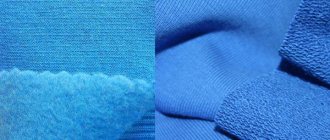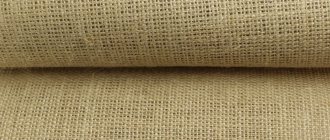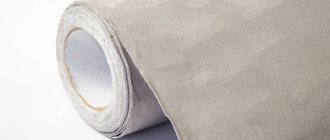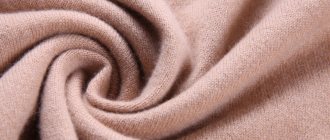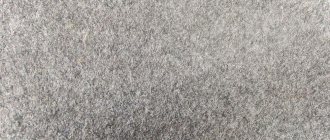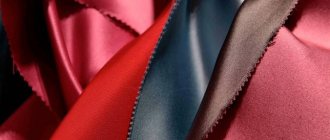Since ancient times, every woman has wanted to have a cashmere shawl made from real goat down in her wardrobe. The product was threaded through the ring - if it passed easily, then the quality of the material was high.
Cashmere is a yarn obtained from goat hair. Just like mohair, it is worth its weight in gold, and even more: it is called “wool diamond”. Things made from Kashmir down are of high quality; they serve as an indicator of a person’s good status. Prestigious material is sold in Asia, Europe and America.
Cashmere is made from the wool of Tibetan goats, which live in the mountainous regions of India, Mongolia, Pakistan, and China. As in the case of Angora goats, when the climatic zone of grazing animals changes, the fleece loses most of its unique properties. It was the characteristics of the mountainous terrain that influenced the formation of the unique properties of this yarn. Temperatures in these areas range from - 40 to + 40 °C. In order to protect themselves from such changes, goats have two layers of hair - fluff on the inside and wool on top.
Historical fact. The fashion for cashmere shawls was brought to Europe by Napoleon, who gave Josephine a wonderful pashmina.
Properties of cashmere
Unlike Angora goats, Tibetan goats are not sheared, but are combed during the spring molt. Moreover, the resulting 150–200 grams of raw material is unrefined cashmere.
After processing the fluff, there remains half as much fluff. This is why cashmere is so expensive. The undercoat of goats is highly valued in the consumer market; it is specially combed and used to create fabrics and yarn. One goat produces very little fluff; it is impossible to knit even a scarf from this amount. Cashmere thread is very thin, thinner than a human hair. It is woven only by hand. Painting is also done mainly by hand. Due to the cavities inside the hair, cashmere yarn is much warmer than wool.
The raw materials are soft and tender. It is often mixed with other fibers to give products greater strength and elasticity. Natural shades include white, brown, gray and black.
- Cashmere outweighs sheep's wool.
- Delicate threads are suitable for hand and machine knitting.
- The material does not irritate sensitive skin.
- No pellets are formed on the finished canvas.
- The items are comfortable to wear.
Varieties
Of course, cashmere is a very expensive material, however, items made from it often offered on store shelves vary greatly in cost. The price tag of the finished product is influenced by the type of fabric, its density and shade of the original fiber, as well as the country of origin.
Today, the market is overflowing with Indian, Turkish, as well as Italian and French cashmere, which is divided into several main categories.
- Pashmina. This fabric consists of fluff with the finest hairs (less than 15 microns); it is used to make almost weightless shawls, the cost of which on the market starts from 15 thousand rubles.
- Half pashmina. The raw materials for its production are fibers up to 19 microns in size. This material is used to sew sweaters, dresses, skirts, and even outerwear.
Based on the type of thread, there are three subtypes of yarn.
- Mongolian. In this case, the fluff of several varieties of Chinese and Mongolian goats is taken. Such raw materials are subjected to the most careful processing and manual combing. Items made from Mongolian cashmere are very soft, they do not deform during wear and do not become covered with pills.
- Cashmere material for coats. This fabric is obtained by combining cashmere and other types of wool. As a rule, there is only 30% fluff in such material, but this amount is quite enough to make the fabric soft, warm and wearable. Most often, cashmere is supplemented with alpaca wool.
- Double-sided coat material. Used to create exclusive coats from leading designers, most often they are made in limited quantities. This material consists of two sheets of wool, which are held together by fibers. As a rule, one side is single-color, and the second is made in the form of drawings.
The quality of cashmere is directly related to the way the yarn is carded - the more “flocked” the item looks, the sooner it will wear out, so cashmere fibers are usually spun in such a way as to smooth out their “shaggyness” as much as possible. To do this, the threads are strongly twisted, and even form an ornate structure by combining the twisting of 2-3 separate threads.
Before spinning, combing is carried out; its task is to separate individual clumps of wool and create even fibers. Modern industry has automated this process - the raw material is passed through a carding machine, where it moves in a large drum, passing through sharp needles and bristles.
If, at the end of such processing, the raw material goes directly to the roving and then to the spinning unit, then card material is connected. And if it is simultaneously processed on a combing machine, then the output is combed cashmere. This fabric is even smoother, thinner and softer. Combed material is priced much more expensive than carded material, but it is a fair difference.
You will learn more about Mongolian cashmere by watching the following video.
Cashmere varieties
The cost of cashmere is determined by the thickness and color of the hair. Pashmina, in which the fluff fibers are no more than 15 microns thick, is the undercoat combed from the belly and neck of the goat. Cashmere or semi-pashmina with a fiber thickness of more than 15 microns. One of the most expensive types of cashmere is worsted yarn, this is a fiber processed by a comb. This treatment removes all roughness and short fibers.
How to distinguish original material from fake
There are no tests that reliably identify 100% pashmina. An inexperienced buyer is unlikely to be able to determine the quality of the material by touch and sight. But you can try:
- the fabric seems to be covered with haze. The effect occurs due to the finest hairs of fluff;
- the canvas is matte, has no shine or shimmer;
- the shade of the item is muted, mostly natural - beige, sand, gray, black;
- natural raw materials quickly absorb and retain heat. Squeeze the clothing in your palm and wait 10 seconds. During this time, the fluff will warm up from the warmth of your hands.
If you are afraid of making a mistake, it is better not to take risks. Shop from brands you trust, or go to a second-hand store.
Cashmere yarn
Soft and delicate fluff produces a fragile cashmere thread, so it is always mixed with others. The natural color of cashmere is white, grey, brown or black. But any color has a characteristic smoky shade. The most expensive is undyed yarn. In any case, cashmere is matte, it cannot be bright and glossy. Cashmere yarn is quite elastic and does not pill. The more tightly the thread is twisted during spinning, the softer and lighter the finished product is. Cashmere thread is very light. And in softness this material is superior to silk.
The best patterns for knitting from yarn with cashmere on the People Knit website.
The best manufacturers
When choosing high-quality cashmere yarn, you can rely on well-known world brands that specialize in the production of natural yarn of the highest quality. Such a guarantee for the buyer can be the Italian company Lana Grossa, designer yarns from the Debbie Bliss and English wool produced by Rowan .
Yarn manufacturers from China also paid attention to the breeding of unique goats. Currently, you can find many Chinese-made wool products on the market, but the quality of the products varies greatly. In this case, you can trust reliable trading organizations that check the quality of goods.
Wash
Cashmere items are recommended to be washed by hand in cool water, the temperature of which does not exceed +30 °C. You can add baby shampoo or powder to the water. Stains on clothing are pre-treated with soap, and only after that the item is soaked in a soap solution for 20–25 minutes.
After rinsing the knitted item under running water, you can leave it in the sink for a while to let the water drain.
Push-ups are not recommended. Drying the product on a clothesline is also impossible; it is best to lay it out on a horizontal surface.
Care
Caring for cashmere should be gentle and soft, because the fabric is very delicate and sensitive to any rough manifestations in the form of twisting and friction.
Wash. You can wash cashmere products by hand, or in a washing machine. The water should not be hotter than 30 degrees. Turn items inside out before starting the wash cycle. Use liquid gels for gentle washing or wool.
A cashmere blanket does not need frequent washing. To maintain its cleanliness and freshness, it is enough to ventilate it in the fresh air once a week.
Spin. If you washed it by hand, then you need to gently wring out the item, freeing it from the main amount of water. Cashmere cannot be twisted, as this will permanently deform the fabric. In the washing machine, use minimum spin speed.
Drying. Cashmere items should be dried horizontally. Place the newly washed item on a terry towel, and after most of the moisture has been absorbed, place the item on another dry surface.
Ironing
You need to carefully smooth out any wrinkles that appear; it is better to use steam, but if this is not possible, then hang the item in the bathroom and turn on the hot water. The steam will smooth the item
Do not use a hot iron on cashmere. The last resort is a lukewarm iron through damp gauze.
Storage. Knitted sweaters, scarves and cashmere shawls can be stored folded on a shelf. At the same time, there should be no rough creases on things. Store coats, skirts, dresses and jackets on hangers, straightened out.
Foreign odors. Cashmere absorbs odors well. And to get rid of them, just ventilate the product on the balcony. This is especially good to do in humid weather.
Spools. A special electric machine or toothbrush helps get rid of pellets. And if there are not many of them at all, then you can manually clean your favorite item.
Now, knowing how to care for cashmere, you can maintain the original and attractive appearance of goat down products for as long as possible.
Storage
Cashmere clothing should be stored in a dry and dark place, since humidity and direct exposure to ultraviolet radiation have a detrimental effect on the material. A plastic bag or special wrapping paper will help protect products from dirt and dust.
Unfortunately, you and I are not the only ones who find cashmere items attractive; moths also do not ignore them. Therefore, when storing, do not forget to add special insect repellent.
Calculation taking into account the knitting method
A common and simple way to determine the amount of yarn for a product is to calculate according to the selected hand knitting pattern. Cashmere yarn is sold in skeins of 50 and 100 grams, but due to its thinness, up to 700 meters of thread can be placed in one skein. To knit thick items with knitting needles, the threads will have to be folded several times, from 3 to 6, which will reduce the total length of the skeins.
For a more accurate calculation, you need to knit a sample of 10 loops for 10 rows, and then measure how much you got in centimeters . Having unraveled the sample, you need to measure the piece of yarn that was used for it. This way you can find out what area of knitted fabric is obtained from the length of one skein, and calculate how many will be needed for the entire product.
What is knitted from cashmere
If you want to emphasize your business style, cashmere will come in handy. It is used for knitting women's and men's items.
Classic always remains in fashion, and together with noble cashmere you will be irresistible. Is not it so?
Let's not forget about our men.
